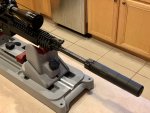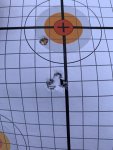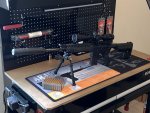When I read the title, I knew it was an AAC can with a 51T mount. Sure enough, it was. Didn't bother reading the other posts, BTDT and I know pretty much everything there is to know about these goddamn things with respect to making them work. Also been in enough of these threads to have a good idea what's being said anyway.
I own four of these motherfuckers and have been through several mounts, don't ask, and can help you out (well, two ea. 556SD's and SDN6's, basically the same thing and definitely the same problem). First let me say AAC did make a good can. They're solid and well made and they do the job. The SDN6 works phenomenally well with the .300BLK and it's quiet. However, their mounts SUCK and their engineers just would NOT listen and their RnD guy was online constantly defending the shitty design instead of fixing it. They just wouldn't let go of that damn ratchet design and STILL use it today. They claim it's just "axial rotation" but that's bullshit and you don't want that either anyway! The movement can range from nothing to some axial rotation to absolute wobble such that it eclipses the bore. I had an FAL mount just like that, took YEARS to get them to give me a replacement!
You have a few options and I'll list 'em from best to worst:
1: Swap it out: If it's for a precision rifle, get a TBAC and don't look back. If you need an abuse can (mag dumps, full auto, etc.) consider a Sico Saker --you can find 'em on sale and they're solid cans that addressed ALL the problems AAC has including the tuning fork flash hider. Got two this summer for less than $500 ea., mounts plus brakes were $150 making both cans $1300, about how much they cost new when they came out. This is the easiest fix and then you can put those AAC cans on something like a rack grade M4(s). There are of course other great mfg.'s out there that make good cans, but I know these, own these, and furthermore, with respect to the Saker, I don't think you can find a better can in it's class for the price when they go on sale, and when they do the BOGO in the summer, well, it gets even better. TBAC will handle more abuse than you think but due to the nature of those cans it's wise to call them and get the exact specs for your application. They make a 5.56 hard use can now as well, I don't have one but knowing TBAC it's probably amazing. Elite Iron is another good one, precision, hard use, high performance, low cost, all rolled into one. KAC is great but it's gonna be costly and I'd go that route if I had a KAC rifle or upper with the mount already.
2: Keep 'em but fit 'em properly: My favorite 51T method, basically order the right one. In order to do this, you're gonna have to buy about ten or so mounts. What you do then is carefully test YOUR cans to those mounts. You're looking for one that locks up tight like it should, like you'd expect from the factory. But their QC and tolerances are such that this is about the only way to mate a can with it's proper mount. Once you find the ones that fit, send the rest back for the refund. Unless you have a shop or dealer that'll just let you fit it right there on the spot, which would be nice.
3: Fix the existing mounts you have. There are numerous ways but they all involve mating the bevel portion of the mount to the can such that it'll latch properly. Light grinding and stoning can reduce that part to the point the ratchet will grab the next tooth, giving a solid mount. But if the bevel isn't perfect, it'll leak or cause other issues. It can be done by hand or by dremel, hand is better, but ideally the way to do this is with the proper tools and either a lathe or a mill, or even a drill press and certain fixtures, tools. This is the most haphazard way of doing it, the hardest and most time consuming, the most prone for error. But I've done it before using a machine blue marker and a fine whetstone of all things, and six hours later I had a perfect mount. SIX HOURS of tedious stoning and bluing. Some folks buy Viton seals, they're like rubber but MUCH higher heat, and they put that between the bevel and the can and it will squish down enough when you tighten it on that it'll cause it to latch and seat without leaking and without any grinding. But you have a Viton ring to keep track of when you take it on and off, sorta negating that QD feature IMO. Note any grinding or modification will void warranty but good luck getting them to honor a warranty in the first place. If you DO have a strike in a can, do not show or send them the modified mount!
As for the mounts, IME the brakes seem to be made to a closer tolerance? Anyway, they don't "TWANG!" when you fire so get those instead. Brakeout doesn't bring anything to the table really but it doesn't twang. The old ones worked okay I guess, better than I'd have given 'em credit for. Not so sure about the non-timed new ones though. Stick with the brakes. There are ways to take the twang out of the flash hiders, generally by removing material from the tines with a mill. Or you can fit and weld a ring to the end of the tines (which also keeps it from snagging on vines if that's a problem). Better off with the brake and it looks cooler to boot.
Ideally you'll order ten brakes or so and find the right one (or ones if it works out that way) and send the rest back and never look back. They'll fit snug and there won't be any wobble and the group should go back to a group with a somewhat repeatable POI. However, I felt it better to just relegate these AAC cans to SBR's and rack rifles and go with something more solid for precision anyway.
Good luck and hope this helps anyone else with an AAC can.








